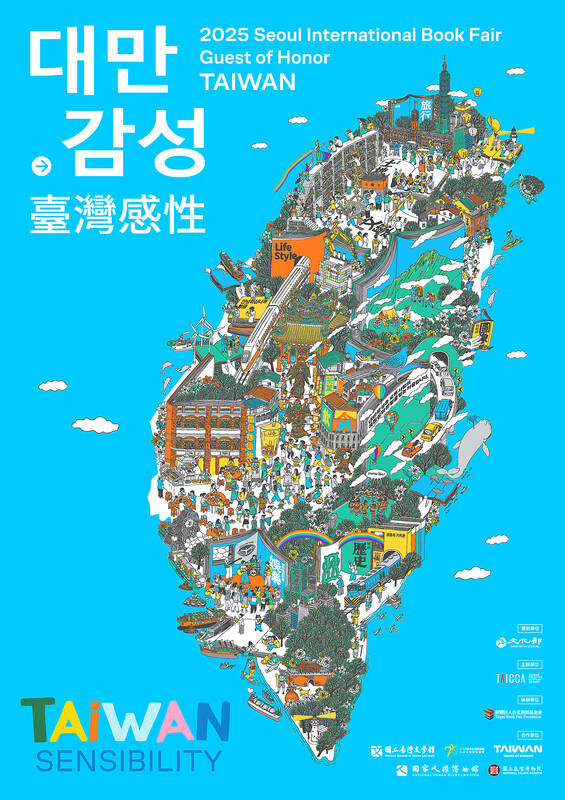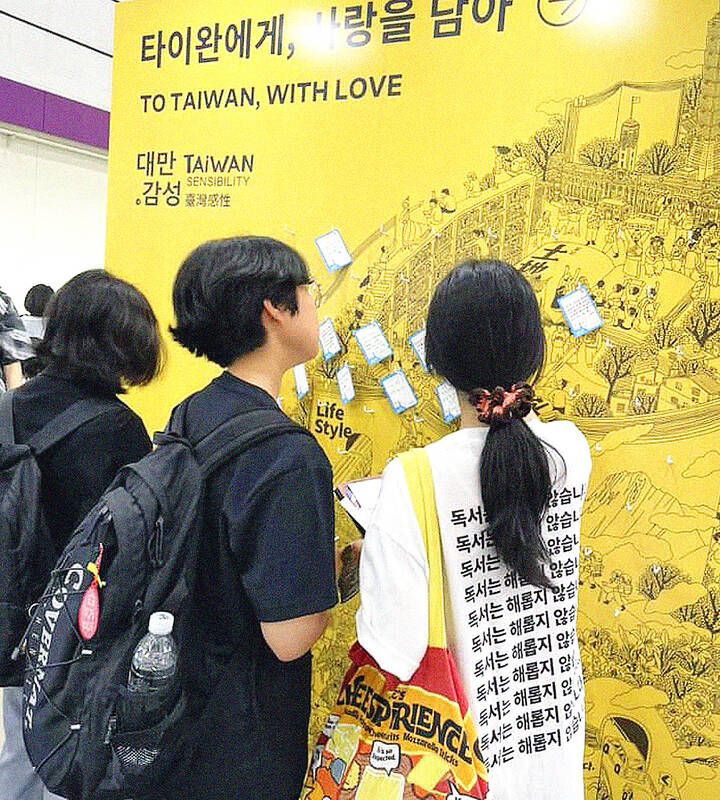The 2025 Seoul International Book Fair was held from June 18 to 22 at the COEX Convention & Exhibition Center in Seoul, South Korea. This year, participants from 17 countries attended, with over 530 publishing houses and related organizations taking part.
For the first time, Taiwan participated in the book fair as the Guest of Honor, bringing together more than 85 publishers and presenting a curated selection of 550 titles. A delegation of 23 Taiwanese creatives traveled to Seoul to attend the event, including 13 literary authors, six illustrators, and four comic book artists, among which were a film director, an actor and the leader singer of a band.
The Taiwan Pavilion was curated around the theme of “Taiwan Sensibility,” and featured six thematic zones: Literature, Lifestyle, Visual Arts, Land & Travel, Food & Entertainment, and History. Through these themes, the pavilion aimed to convey the diversity and creative vitality of Taiwanese culture.

Photo courtesy of Taiwan Creative Content Agency 照片:文化內容策進院提供
Curatorial advisor Rex How (郝明義) noted that in recent years, the phrase “Taiwan Sensibility” has gained popularity in South Korea, evoking impressions of warmth and amiability associated with Taiwan.
At the pre-departure news conference, Taiwan’s Minister of Culture Li Yuan remarked: “What is Taiwan Sensibility? It is the spirit of a small island encircled by the sea and crowned by mountains, repeatedly swept into the tides of global history — colonized, invaded, yet never subdued. Its people have cultivated a resilient inclusiveness, absorbing foreign cultures, connecting swiftly with the world, and developing a unique cultural depth that, at last, is being seen and recognized.”
Throughout the fair, the Taiwan Pavilion hosted many events, inviting creators, translators and publishers from both Taiwan and South Korea to engage in themed dialogues and discussions.

Photo courtesy of Taipei Book Fair Foundation 照片:台北書展基金會提供
Writer Wu Ming-yi observed that Taiwan is a place that was once abandoned, yet longs to be discovered. He expressed heartfelt gratitude to the readers who strive to understand Taiwan through his writing.
Heo Yu-yeong, the translator of Wu and Chen Xue’s novels into Korean, noted that both authors possess distinctive rhythms and aesthetic qualities that diverge sharply from the more fast-paced style typical of Korean literature. These nuances, she said, present the greatest challenges in translation.
Wu acknowledged that his writing draws on multiple languages — Mandarin, Taiwanese Hokkien and Indigenous languages among them — posing considerable difficulties for any translator. Heo laughed as she admitted that rendering these multilingual expressions took immense time and effort, sometimes requiring an entire day to research the meaning of a single word. And yet, she added, that wasn’t even the hardest part.
More difficult, Heo explained, was preserving the strong stylistic identity of Wu’s work. She had to follow his pacing with great care, and often hesitated when adjusting sentence structures for fear of disrupting the feeling.
The same held true in her recent translation of Chen’s novel Skyscraper, published in South Korea earlier this year. Heo explained that unlike a typical mystery novel, Skyscraper slows in pace as it unfolds, requiring deliberate word choices throughout in translation. She paid particular attention to keeping the tone understated — especially in adjectives — to preserve the elegant melancholy of Chen’s wording.
Chen, with several of Chen’s works addressing LGBTQ+ themes translated into Korean, drew keen interest from the South Korean media, signaling the local South Korean readership’s growing curiosity about both Taiwanese literature and marriage equality issues.
Having translated many works of Taiwanese literature, Heo observed that Taiwanese fiction tends to move at a gentler, more introspective pace compared to its Korean counterpart. Taiwanese authors often favor longer, more descriptive sentences, especially in their openings, emphasizing scene-setting over immediate action.
Unlike K-dramas, which often begin with explosive plot points, Taiwanese narratives unfold slowly, which — though unfamiliar — has nonetheless captivated the imaginations of many South Korean readers.
Heo further noted that Taiwan and South Korea share similar historical traumas and trajectories of economic and social development, as well as cultural backgrounds. This creates a sense of familiarity and emotional resonance for Korean readers — what she described as a kind of shared wound, one that fosters deeper empathy. At the same time, she observed that Taiwan has in recent years embraced greater openness, particularly in its literature and legal recognition of same-sex marriage. This contrast has sparked a growing sense of curiosity among younger South Korean readers, who are drawn to the differences born from such a similar starting point.
(Translated by Lin Lee-kai, Taipei Times)
2025首爾國際書展6月18日至22日在韓國首爾COEX展覽中心舉行,本屆書展邀集17國、餘530家出版社及出版相關團體參與。
台灣今年首度以「主題國」身分參展,集結超過85家出版社、550本精選書目,並有23位創作者親赴參與,包括13位文學作家、6位繪本創作者、4位漫畫家,其中有幾位作者也是電影導演、演員與樂團主唱。
台灣館以「台灣感性」為策展主軸,透過文學、生活風格、圖像、土地與旅行、飲食與娛樂、歷史等6大主題區,呈現台灣文化的多樣性與創意生命力。
策展顧問郝明義介紹,韓國人近期提到台灣時,經常使用「台灣感性」這個詞,給人溫暖、親切的印象。
文化部長李遠在行前記者會致詞時指出:「什麼是台灣感性?一個有高山被海洋圍繞的小島,被一次又一次捲入世界的大歷史中,被殖民被侵犯。但島上的人卻練就了一種包容韌性,吸收外來者的文化,迅速與世界接軌,發展出自己獨一無二的文化底蘊,終於被世界看見」。
台灣館舉辦了多場活動,邀集台韓兩地的創作者、譯者及出版社代表進行主題對談。
作家吳明益表示,台灣是一個曾經被放棄的地方,也是一個渴望他者可以認識自己的地方,特別感謝那些願意透過他的作品理解台灣的讀者。
將台灣作家吳明益、陳雪著作翻譯成韓文版的譯者許裕暎指出,兩位作家的小說都有自己特有的節奏與氛圍,不同於一般韓國作品的緊湊,是翻譯時最難詮釋的部分。
吳明益表示,他的作品中涉及中文、台語、原住民語等許多不同的語言,應該讓譯者很辛苦;許裕暎笑說,翻譯這些不同語言的詞語確實花了不少時間,有時候甚至要花上一整天來查找一個字,但這還不是最困難的部分。
許裕暎指出,吳明益的個人風格強烈,為了保持整體氛圍,她必須很小心地配合作者本人的寫作節奏,在修改結構的時候也經常很猶豫。
翻譯陳雪今年初剛在韓國出版的小說《摩天大樓》時也是如此,她說明,《摩天大樓》節奏不似一般推理小說緊湊,反而越往後發展、節奏越緩慢,必須字字推敲,例如在形容詞上盡量選擇比較「低調」的用字,保持陳雪文中那種優美、憂鬱的感覺。
陳雪有多部同志議題作品被譯為韓文,特別受到韓國媒體關注,顯示韓國讀者對台灣創作與同婚議題的高度興趣。
翻譯過多本台灣文學作品的許裕暎說,與韓國作品相比,台灣小說的特色是節奏比較緩慢、沉靜,偏好使用較多修飾、較長的句子,尤其是開頭較注重背景描寫,不會像韓劇一樣第一集就有爆點,雖然跟韓國人習慣的節奏很不一樣,但也吸引了許多讀者。
許裕暎指出,台灣與韓國有類似的歷史創傷與經濟社會發展、文化背景,讓韓國讀者在閱讀台灣作品時較容易感受到「同質感」,也可以說是一種「同病相憐」,更能打動韓國讀者;另一方面,在極為類似的背景下,近年台灣卻更為開放,社會在台灣小說及同性婚姻合法化等各方面展現多樣性,也讓韓國年輕讀者開始對這種差異感到好奇。
(中央社)

An automated human washing machine was one of the highlights at the Osaka Kansai Expo, giving visitors a glimpse into the future of personal hygiene technology. As part of the event, 1,000 randomly selected visitors were given the chance to try out this cleansing system. The machine operates as a capsule-like chamber where warm water filled with microscopic bubbles gently washes away dirt. The 15-minute process also includes a drying phase, removing the need for users to dry themselves manually. Equipped with advanced sensors, the device monitors the user’s biological data, such as their pulse, to adjust water temperature and other settings

Britain’s National Gallery announced on Sept. 9 that it will use a whopping £375m (US$510m) in donations to open a new wing that, for the first time, will include modern art. Founded in 1824, the gallery has amassed a centuries-spanning collection of Western paintings by artists from Leonardo da Vinci to J.M.W Turner and Vincent van Gogh — but almost nothing created after the year 1900. The modern era has been left to other galleries, including London’s Tate Modern. That will change when the gallery opens a new wing to be constructed on land beside its Trafalgar Square site that is currently

It is a universally acknowledged truth that Jane Austen, born in 1775, is one of the most beloved English novelists, and that her works still inspire readers today. She is renowned for her novels Pride and Prejudice, Emma, and Sense and Sensibility. Her stories often explore themes of love, marriage, and social status in late 18th-century British society and are written with wit and insight. To honor her legacy, the Jane Austen Festival is held every September in Bath, England. She lived there for several years, and the city is depicted in two of her novels. The festival began in 2001

Firefighters might face an increased risk of developing “glioma,” a type of brain cancer, due to certain chemicals encountered on the job. A recent study analyzed glioma cases and found clear connections between the genetic patterns of affected firefighters and their exposure to these harmful substances. The study found that firefighters exhibited significantly higher levels of specific mutational signatures in their glioma cells compared to individuals in other occupations. These signatures — unique patterns of genetic changes in DNA — help scientists trace the source of mutations. Earlier research has associated these mutations with certain chemicals found in fire